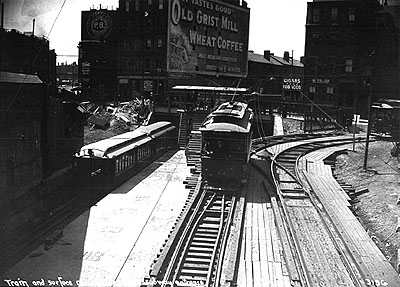F-Line to Dudley
Senior Member
- Joined
- Nov 2, 2010
- Messages
- 9,553
- Reaction score
- 10,422
Well I was thinking of a hybrid approach, where you stay at the surface until the last block to get into the transitway tunnel. Even if that's the hardest place to tunnel, at least the rest is relatively cheap. Perhaps Oak St + Tai Tung St could be used as a dedicated transitway as well (with a stop at Tai Tung park for mitigation)...
Not going to work. This adorable thing is what Oak turns into on the block between Harrison and Tyler. Yeah...um, no. And Harrison's a one-way southbound. Even if you could 2-way it (which you really can't), the next available block is...Marginal @ Curve. Back to the Pike-hugging alignment we started with.
Your only other option on fully 2-way streets is Oak-->Washington-->Kneeland. No way with those traffic levels.
So...all roads point to Marginal.
The other thing to consider is how deep the Transitway is. Even on steep grades the trolleys can handle with aplomb you'd need a good 500-600 ft. runup to plumb those depths. Tracing back from the point it punches into the Transitway, that puts you close to the back parking lot of Ginza Japanese Restaurant as your first chance to pop the surface. 150-200 ft. from the Hudston/Kneeland intersection. And you've already mitigated two-thirds of the buildings on Hudson for the Kneeland-Beach block to get this far.
So it's extremely awkward to stop there. The trolleys have a nightmarish Kneeland intersection to contend with, and the Kneeland-Beach block has to go car-free to fit the 2 trolley tracks that run on-street that last couple hundred feet. Not cool when all those storefronts and restaurants are served by delivery trucks from on-street.
In all likelihood you can't stop there, and have to keep going across the intersection. Next opportunity to portal-up is that park that's going behind One Greenway on the SS Connector block. +500 ft. of extra tunneling from the 600 you already dug...this time at level-grade, standard-depth with that One Greenway promenade offering up more breathing room. Consider it 90% likely you're going to have to reach this far because the impacts of scurrying to the surface on the other side of Kneeland and banning autos from that block of Hudson is too much punishment for the neighborhood. And really lousy for the trains that have to now cross Kneeland. It's a near non-optional.
So, for all practical purposes if you want into the Transitway you have to build 1100 ft. of tunnel and mitigate ALL the hard parcels in Chinatown.
That leaves only:
-- Tremont St. tunnel reactivation + Tufts station + 900 ft. of tunnel to the Herald side of the Pike to get the base build serving either/both the Seaport and Dudley legs.
-- 1700 ft. of the easiest digging of them all from the Marginal/Shawmut intersection where the Dudley and Seaport legs would split to your Transitway portal-in-the-park.
Really...if front-loading the Transitway incline you've done almost two-thirds of the work and cost; it's silly to leave a gap in the rest when the rest is all the easy digging.
I could see the phasing working the opposite way like I described in the last post: 1) getting Tufts + the Dudley portal built, 2) going SS surface or bus station from there in the interim, 3) THEN building the hard part. But not in reverse when the feat of completing the way into the Transitway puts the wind well at your back for the rest. That's sort of a rough and much more expensive analogue for "Eh, fuck it. Let's just end the Transitway here, make the Silver Line cross D Street, and not put any direct ramps onto the Ted." Giving up on it right on the cusp of the follow-through...after they've already pulled off the feat of doing the hard part.

